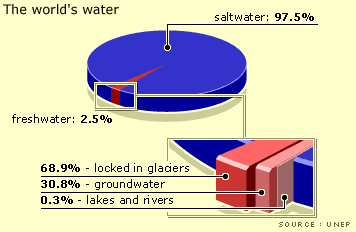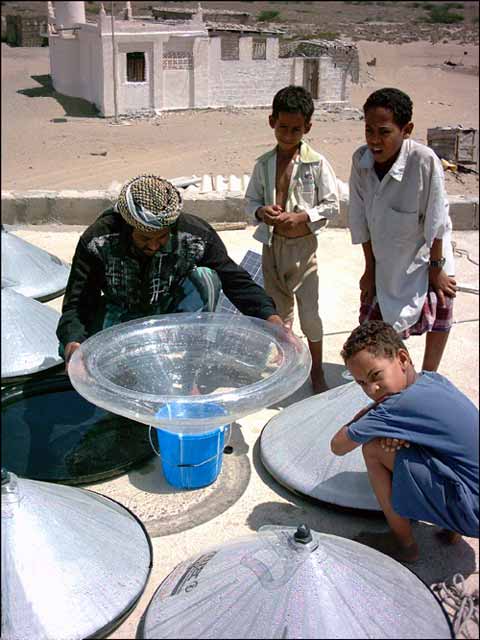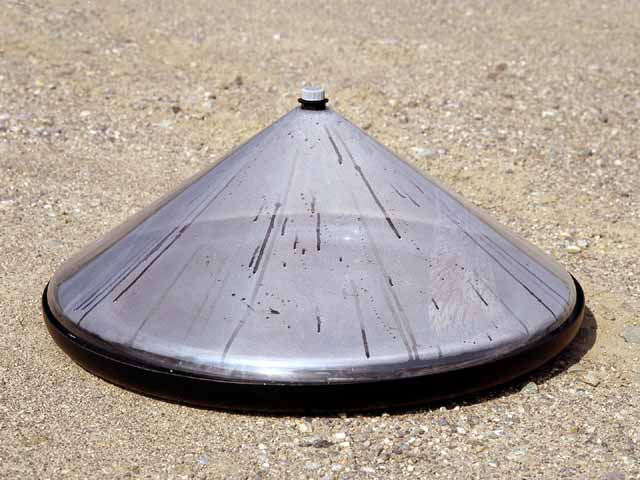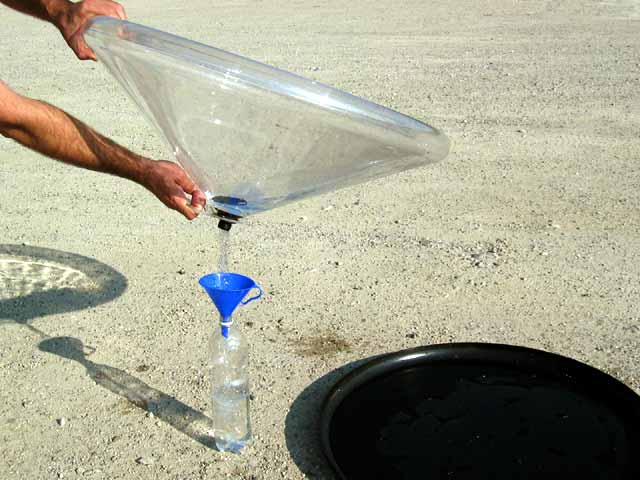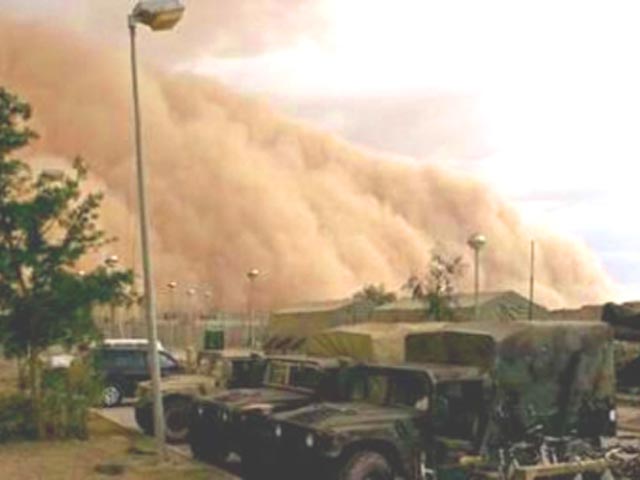One Billion People Are Thirsty
Water "Wake-up Call" Given by the UNWith an average elevation of 8,000 feet, Antarctica is the highest continent and holds 70% of the earth's fresh water.
by Imogen Faulkes More than 40% of the world's population does not have even the most basic sanitation. More than one billion people have no access to clean water sources. There are 45,000 big dams in the world - nearly half in China and more than 6,000 in the US. Unfortunately, more water is lost through evaporation from dam reservoirs each year than is consumed for domestic and industrial use combined. Last century saw a dam-building boom - but the pace has slowed as many doubt that the benefits outweigh the human and environmental costs. Source: news.bbc.co.uk
Water Scarcity Affects One in Threeby Fiona Harvey A third of the world’s population is suffering from a shortage of water, raising the prospect of "water crises" in countries such as China, India and the US. Scientists had forecast in 2000 that one in three would face water shortages by 2025, but water experts have been shocked to find that this threshold has already been crossed. Frank Rijsberman, director-general of the International Water Management Institute, said: "We will have to change business as usual in order to deal with the growing water scarcity crisis." About a quarter of the world’s population lives in areas of "physical water shortage", where natural forces, over-use and poor agricultural practices have led to falling groundwater levels and rivers drying up. But a further one billion people face "economic water shortages", because lack the necessary infrastructure to take water from rivers and aquifers. The findings come from a report compiled by 700 experts over 5 years, the Comprehensive Assessment of Water Management in Agriculture from the International Water Management Institute, presented on Monday at World Water Week in Stockholm, an international meeting of water experts. David Molden, co-ordinator of the report, said: "If we continue to manage water in the way we do now, there will more problems with scarcity." He said agricultural practices could easily be improved to reduce the wastage of water. Farming uses up 70 times more water than is used for domestic purposes such as cooking and washing. In Thailand, the amount of water used to grow food is about 2,800 litres per person per day. In Italy, about 3,300 litres are required to produce each person’s food every day, of which about half goes on making ham and cheese and a third to pasta and bread. Shortages of water are already biting in countries such as Egypt, which imports more than half of its food because it lacks enough water to grow more. In Australia, there is a water shortage in the Murray-Darling basin because so much has been diverted for use in agriculture. In the US, there are increasing disputes with Mexico over the sinking levels of water in the Colorado river. Water shortages are compounded by corruption, according to Transparency International. David Nussbaum, chief executive, said between 20 and 40% of total investment in the water sector "does not flow to the people who should be getting the clean water and sanitation". He said big water projects, such as the construction of water networks and treatment facilities, were subject to corruption on a grand scale, but that petty corruption was also common, for instance in cases of people paying bribes to have their water bills reduced. The result of both was that it cost poor people more to get access to water, he said. But he pointed to the success of a high-profile water "integrity pact" developed in Karachi in Pakistan since 2002 and completed in May this year, as an example of how water projects could be made more transparent. He said the pact had saved at least $3 million that would otherwise have been lost to corruption. Source: www.ft.com 21 August 2006 © The Financial Times Limited
Watercone®
A Watercone® is simple. Anyone can use it. It is cheap, mobile, and solar-powered. It allows any individual to generate potable water from sea water or brackish water. Technically, it is a "solar still" which operates on the principle of evaporation/condensation. The clever design is conical and its parts are stackable (making shipping in quantities easier); it is made of lightweight, transparent, thermo-formable polycarbonate. It is outfitted with a screw cap spout at the tip and an inward circular collecting trough at the base. Directions for Use
Technical InformationThe Watercone® system is a one step water distillation process with a 40% effectiveness rate (GTZ Germany). Based on evaporation levels of 8.8 litres per square metre (the average solar irradiation received in Casablanca, Morocco), the Watercone® (with a base diameter of 60 - 80 cm) yields between 1.0 to 1.4 litres of distilled water per day (over a 24-hour period). The salty / brackish water evaporates through solar irradiation and the condensation from that water appears in the form of droplets on the inner side of the cone wall. These droplets trickle down the inner wall into a circular trough at the base of the cone. By unscrewing the cap at the tip of the cone and gently and carefully turning the cone upside down, one can empty the potable water gathered in the trough directly into a drink container. The cone supplies an innovative solution to a problem which has cursed mankind for millennia: turning salt water into drinking water in an uncomplicated, cheap and swift manner. The Watercone® is long-lasting, UV-resistant polycarbonate; it can be used daily for up to 5 years. The material is non-toxic, non-flammable and 100% recyclable. The black pan for the saltwater is already made out of 100% recycled polycarbonate. Even when the Watercone® becomes old and cloudy, it can still be used to collect rain water or used as a container for other goods. Plus, it uses solar energy rather than gas, oil or electricity to desalinate seawater. In many countries, poor people must boil their water (thus burning their last remaining wood thereby helping to promote the growth of deserts worldwide). Watercone® could be effectively used in these regions as well. Five Reasons for global distribution of the Watercone®
Source: www.watercone.com See also:
Dust Storm in Iraq
A massive sand storm cloud is close to enveloping a military camp as it rolls over Al Asad 27 April 2005
For pages on several types of disasters - including lightning strikes, volcanoes, floods, hurricanes, tornados, global warming and more - and also some great satellite photos and
pictures of castles and beautiful trees, clicking the "Up" button immediately below takes you to the Table of Contents page for this Environment section. |
 Animals
Animals Animation
Animation Art of Playing Cards
Art of Playing Cards Drugs
Drugs Education
Education Environment
Environment Flying
Flying History
History Humour
Humour Immigration
Immigration Info/Tech
Info/Tech Intellectual/Entertaining
Intellectual/Entertaining Lifestyles
Lifestyles Men
Men Money/Politics/Law
Money/Politics/Law New Jersey
New Jersey Odds and Oddities
Odds and Oddities Older & Under
Older & Under Photography
Photography Prisons
Prisons Relationships
Relationships Science
Science Social/Cultural
Social/Cultural Terrorism
Terrorism Wellington
Wellington Working
Working Zero Return Investment
Zero Return Investment